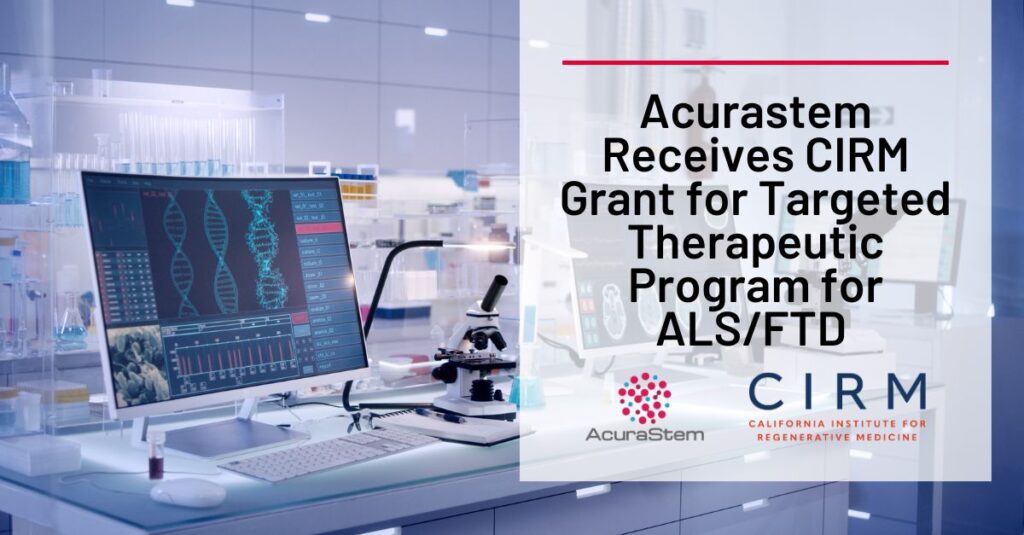Acurastem Receives CIRM Grant for Targeted Therapeutic Program for ALS/FTD

Biotechnology company AcuraStem announced that it has received a $4 million grant from the California Institute for Regenerative Medicine (CIRM) for its targeted therapeutic program for ALS and FTD.
The funding will support the company’s program focused on the UNC13A gene, which plays a crucial role in the progression of ALS and FTD. AcuraStem is utilizing a proprietary platform called iNeuroRx to develop targeted therapeutic compounds to address the dysfunction of UNC13A created by the loss of function in the TDP-43 protein. ALS and FTD cases associated with TDP-43 are usually associated with this dysfunction and abnormal accumulations of the protein.
“The support from CIRM is a testament to the potential of our research and its capacity to address critical challenges in neurodegenerative disease treatment,” said co-founder and CEO of AcuraStem Sam Alworth, MS, MBA. “This funding will facilitate the development of our UNC13A program toward clinical trials, enabling us to leverage our advances to potentially revolutionize the treatment landscape for ALS and FTD.”
The Role of UNC13A
The gene UNC13A encodes a protein of the same name that plays an essential role in the nervous system by facilitating neurotransmission, the process by which neurons communicate with one another. The proteins associated with UNC13A facilitate and mediate crucial steps in the process while also creating and maintaining the structures on neurons where neurotransmission takes place. Proteins associated with UNC13A are also involved in synaptic plasticity, which allows neurons to change their connections in different ways; this is associated with brain functions such as motor control, learning, and memory.
In ALS and FTD caused by a TDP-43 pathology, however, the function of UNC13A is disrupted. TDP-43 protein plays a crucial role in regulating genetic expression, the process where information in genes is converted to products like proteins that aid in body functions. When TDP-43’s normal function is lost in ALS/FTD, disruptive segments of RNA called cryptic exons slip into the messenger RNA that carries blueprints to create UNC13A protein.
The disruption created by cryptic exons then causes a massive drop in functioning UNC13A protein, which in turn leads to the impairment of the neurotransmission process.
Restoring Normal Function with Antisense Oligonucleotides
Using iNeuroRx, AcuraStem was able to recreate a model of TDP-43 pathology using common blood or skin samples from people diagnosed with ALS or FTD. The model includes real, living neurons and support cells, which allow researchers to closely watch as genetic expression dysfunction occurs. The company utilizes machine learning and other techniques to study the model and search for compounds to restore normal cell function.
The platform enabled AcuraStem to quickly develop and test compounds called antisense oligonucleotides (ASOs): brief, synthetic strands that are designed to bind to certain mRNA sequences. The ASOs bind to the cryptic exons in UNC13A created by TDP-43 pathology, suppressing it and allowing the regular functions of UNC13A to resume.
The grant from CIRM will provide support to the company as it brings ASOs for ALS and FTD through the preclinical stage of research. In addition to its ASOs targeting UNC13A, the company previously developed an ASO for the PIKFYVE enzyme, with AcuraStem’s Associate Vice President, Discovery and Early Development, Wen-Hsuan Chang, PhD, receiving a 2020 Accelerating Drug Discovery for FTD grant from AFTD and the Alzheimer’s Drug Discovery Foundation in recognition of the ASO’s potential. The ASO was later licensed to Takeda Pharmaceuticals and is now undergoing clinical trials.
Do you want to participate in FTD research? AFTD’s Studies Seeking Participants page features clinical trials actively recruiting candidates. The FTD Disorders Registry can not only help you keep up to date on trial opportunities, but allows you to share your lived experiences to guide researchers.
By Category
Our Newsletters
Stay Informed
Sign up now and stay on top of the latest with our newsletter, event alerts, and more…

